I have been rather busy for the past week or so. Last Wednesday I enjoyed a quick trip to Birmingham to present a paper at the Enhancing Impact, Inspiring Excellence conference. I have also been finalising the chapter outlines for a book that a colleague and I are currently writing together and preparing to meet some special visitors, as well as carrying on with my everyday tasks and ongoing projects – not least spending time answering enquiries in our reading rooms and by email and live web chat – and, of course, squeezing in the time to research and write this blog post.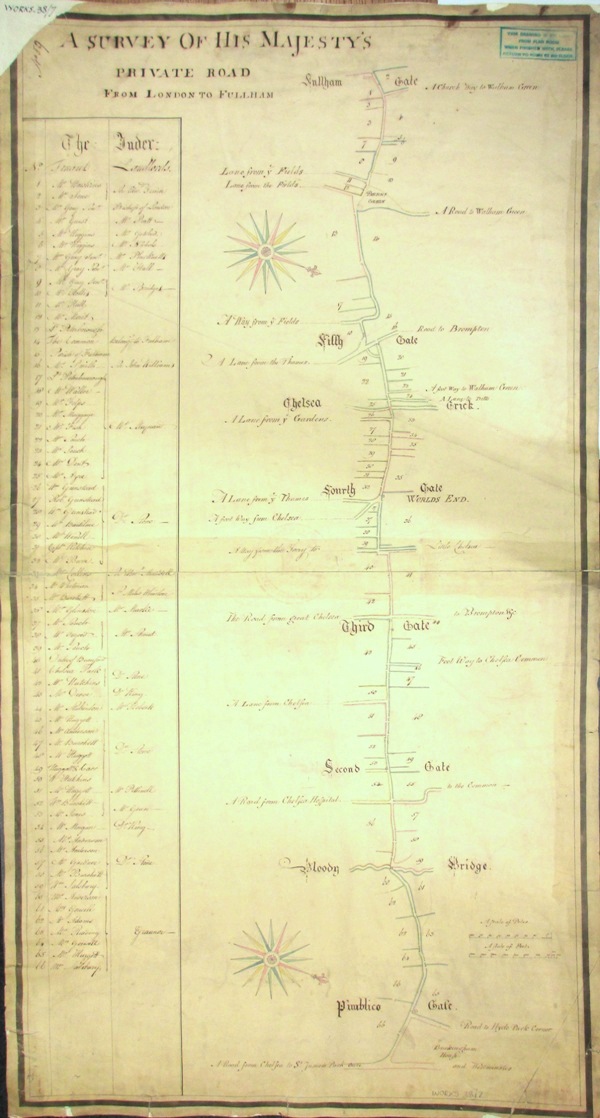
Nevertheless, I found time to go to an evening seminar last Thursday about the King’s Road, Chelsea, in the 1960s. [ref] 1. You can read more about the history of the King’s Road area on the Library Time Machine, a blog by the Royal Borough of Kensington and Chelsea’s local studies librarian. The Virtual Museum section of the borough’s website also offers directions for a walking tour through historic Chelsea. [/ref] It was the topic of this seminar, organised as part of the regular Archives for London events programme, that inspired me to write about a map of this famous London thoroughfare.
This route map [ref] 2. WORK 38/7. [/ref] shows the King’s Road in the early 18th century (almost 250 years before it became the fashionable heart of ‘Swinging London’) when ‘His Majesty’ was King George I. The road itself is even older than this. It was built as a private road for King Charles II in the second half of the 17th century. Members of the royal family used it when travelling between London and their palaces at Hampton Court and, later, at Kew.
The King’s Road remained a private road until 1830, but from around 1720 it could be used by members of the public who had paid for tokens allowing them to travel along it. [ref] 3. Patricia E C Croot, A History of the County of Middlesex Volume 12: Chelsea. (London, 2004). ‘Communications’. Like other volumes of the Victoria County History, this is available on the British History Online website. [/ref] Our map may have been made to help formalise the arrangements for this paid access. Since 1830 the road has been an ordinary [ref] 4. Of course, many people would say that describing the King’s Road as ‘ordinary’ is a misnomer. [/ref] public highway.
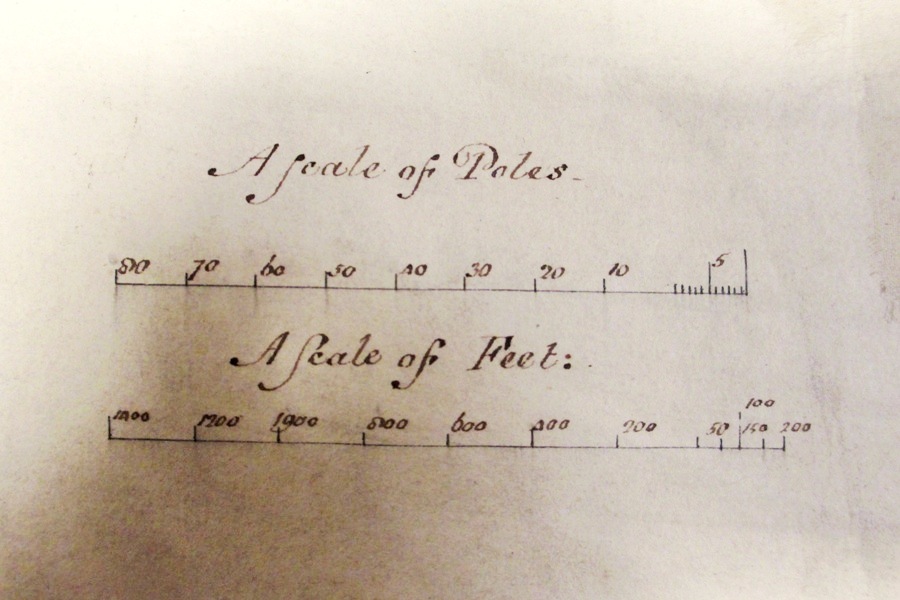 The map is drawn to the scale of 1 inch to about 530 feet. There are two scale bars: one marked in feet and the other in poles. A pole (more often called a rod or perch) is equivalent to 16½ feet or just over 5 metres. [ref] 5. Colin R Chapman, How Much? How Many? How Long? (Dursley, 1995), pp 20-21. [/ref]
The map is drawn to the scale of 1 inch to about 530 feet. There are two scale bars: one marked in feet and the other in poles. A pole (more often called a rod or perch) is equivalent to 16½ feet or just over 5 metres. [ref] 5. Colin R Chapman, How Much? How Many? How Long? (Dursley, 1995), pp 20-21. [/ref]
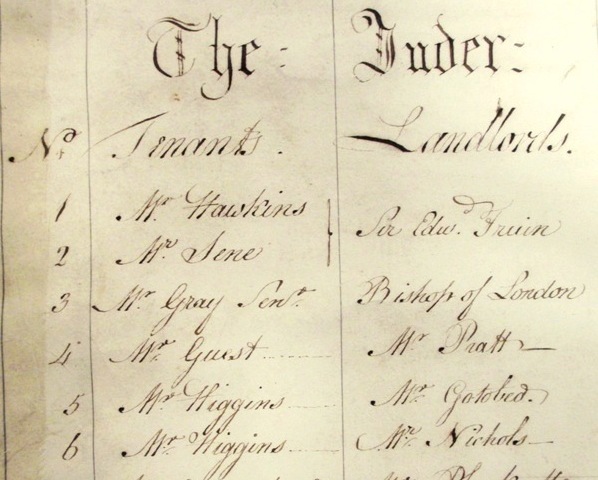 An ‘index’ on the left-hand side of the map forms a key to the numbered plots of land marked on either side of the road. It lists the names of the various landowners and tenants. Maps that mention people’s names can be useful sources for family historians and others interested in individual people or families from the past.
An ‘index’ on the left-hand side of the map forms a key to the numbered plots of land marked on either side of the road. It lists the names of the various landowners and tenants. Maps that mention people’s names can be useful sources for family historians and others interested in individual people or families from the past.
Although showing north at the top had long been standard for printed maps, the same is not always true of hand-drawn maps. These tend to follow whichever orientation fits best on the paper. The two decorative compass indicators on this map reveal that it is drawn with west-south-west at the top.
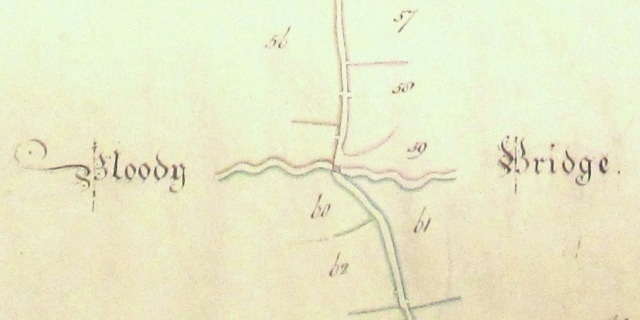 At the time when the map was made, Bloody Bridge carried the King’s Road over the River Westbourne. This river now runs underground in pipes, as a result of 19th century engineering work. One section of it now flows through a conduit above the platforms at Sloane Square tube station.
At the time when the map was made, Bloody Bridge carried the King’s Road over the River Westbourne. This river now runs underground in pipes, as a result of 19th century engineering work. One section of it now flows through a conduit above the platforms at Sloane Square tube station.
The triangular area of open space called Parsons Green has since given its name to a suburb and a tube station. This portion of the road, running from Waterford Road to Putney Bridge – towards the top (Fulham) end of our map – is now called New King’s Road.
If you prefer maps that are a little more modern, you might like this unusual map from the collections of the Museum of London, which shows Chelsea as it was in around 1960.


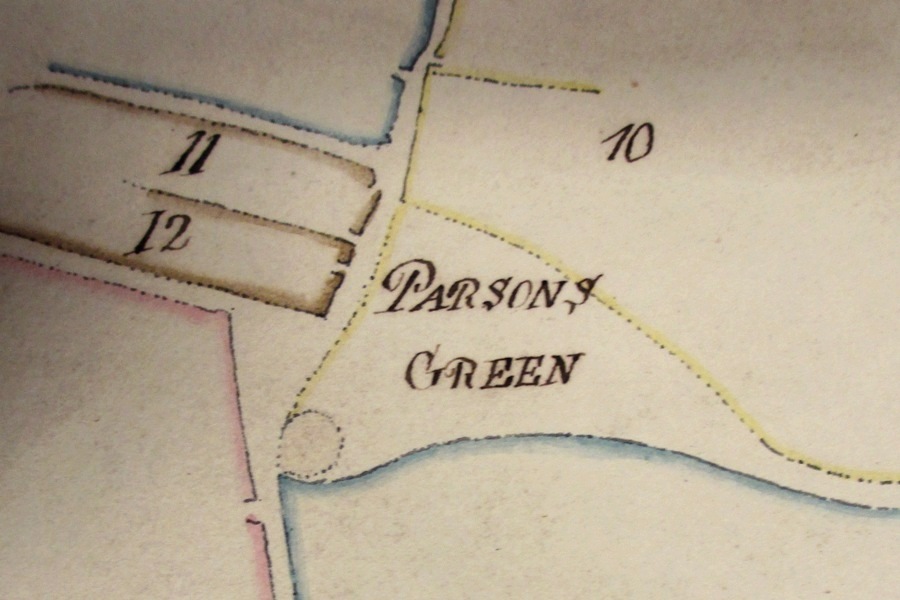
Very enjoyable read. One comment… while *maps* conventionally have north at the top, *surveys* are still orientated whatever way is most convenient to fit on the paper. The assumption is that a technically trained audience won’t be confused by an arbitrary orientation.
Thank you for your comment, Andrew. I’m glad you enjoyed the post – and you make an interesting point about terminology.
Our experience based on the large number of manuscript maps here is that the terminology in titles – where they have titles at all – varies a lot. There is not always a clear difference between something that calls itself a ‘survey’ and those that call themselves a ‘map’, ‘plan’, ‘plat’ or even something else such as ‘diagram’ or ‘drawing’. I don’t know of any systematic studies of correlations between orientation and these ‘type terms’ but I would interested to hear of any.
Very interesting blog entry Andrew. I was just wondering if you had a higher res scan available, because I’d be interested in knowing that names of the landlords and tenants between Chelsea Creek and the Third Gate, especially those around the Fourth Gate (World’s End). Unfortunately the namews are illegible on the scan.
By the way, did you know that this map has been engraved into the paving stones of the new(ish) Duke of York’s Square opposite Peter Jones in the King’s Road … only the map and numbers, no key.
I don’t seem to be able to paste any images here, but here’s a link if you’d like to see a photo I took of a part of it.
https://www.facebook.com/photo.php?fbid=10202394635365595&set=p.10202394635365595&type=1&theater
Thank you for your comment, Chris. I’m glad you enjoyed the post. (I’m actually on holiday this week and only spotted your comment by chance.) I didn’t know that there was an open-air version of the map. I’ll have to take a look some time.
The images that I used for this post aren’t professional scans. I took some photos of the map with my own camera. I’ve had a quick look at the uncompressed photo of the whole map but the names in the key still aren’t completely clear, I’m afraid.
You can order a professional scan from our copying service, or you’d be welcome to visit us and look at the original map.
http://nationalarchives.gov.uk/recordcopying/
http://nationalarchives.gov.uk/visit/
If you do plan to visit us, I’d also suggest looking at another map, with the reference MPE 1/482.
http://discovery.nationalarchives.gov.uk/SearchUI/Details?uri=C4048730
This is very similar to the map featured in this post but not identical. (I haven’t compared the two thoroughly and it’s possible that some of the names may be different.) It’s likely that one was copied from the other but I’m not certain which one was made first.
To make it slightly more complicated, a black-and-white photostatic reproduction of the ‘other’ map (MPE 1/482) was made in the 1930s. There is a copy of this at the British Library (I’ve seen it) and you may find that one or two other institutions have copies too.
Good luck with your research.
This is where we were discussing it:
https://www.facebook.com/photo.php?fbid=10152014414914350&set=gm.546671318758112&type=1&theater
I’m curious why the road had to “wiggle” at Park Walk and Millman Street? In mid-1600’s I assume the King could have ordered anything in his way to be removed to make a straight road. So I am guessing it was a natural obstacle. Perhaps a river running to the Thames or boulders that were too heavy to remove. Any facts on that wiggle? (In a way it’s very endearing now. All the people I know refer to it as the wiggly bit.)
Thanks for your comment, Keith. It’s good to know that this post is still being read six years later.
I’m afraid that I don’t know anything more about the ‘wiggle’ in the King’s Road. (Unlike many of our maps, this one did not come to us with related papers.) Your suggestion of a natural obstacle seems plausible, though. Maybe someone with local knowledge may have an answer(?)